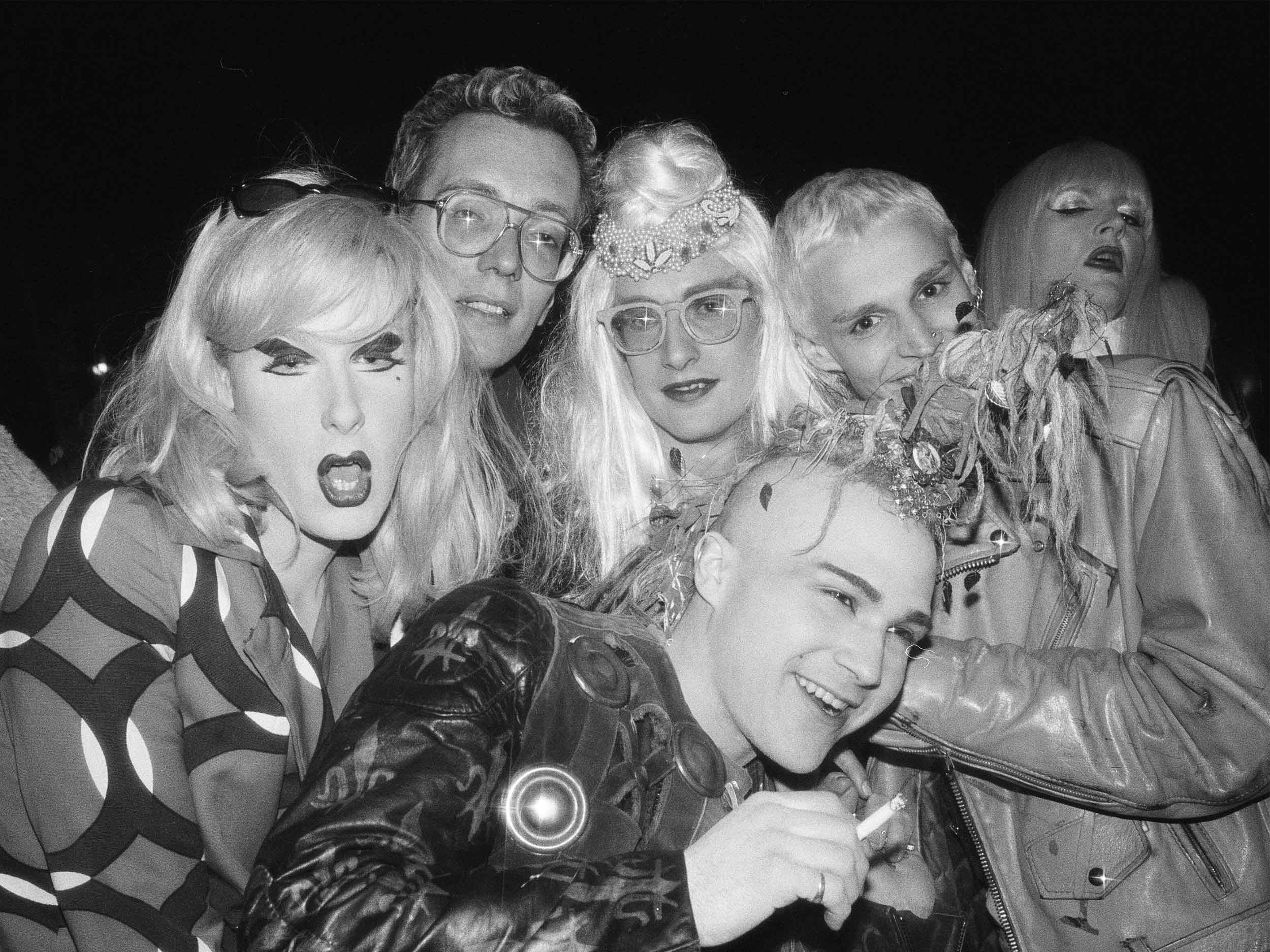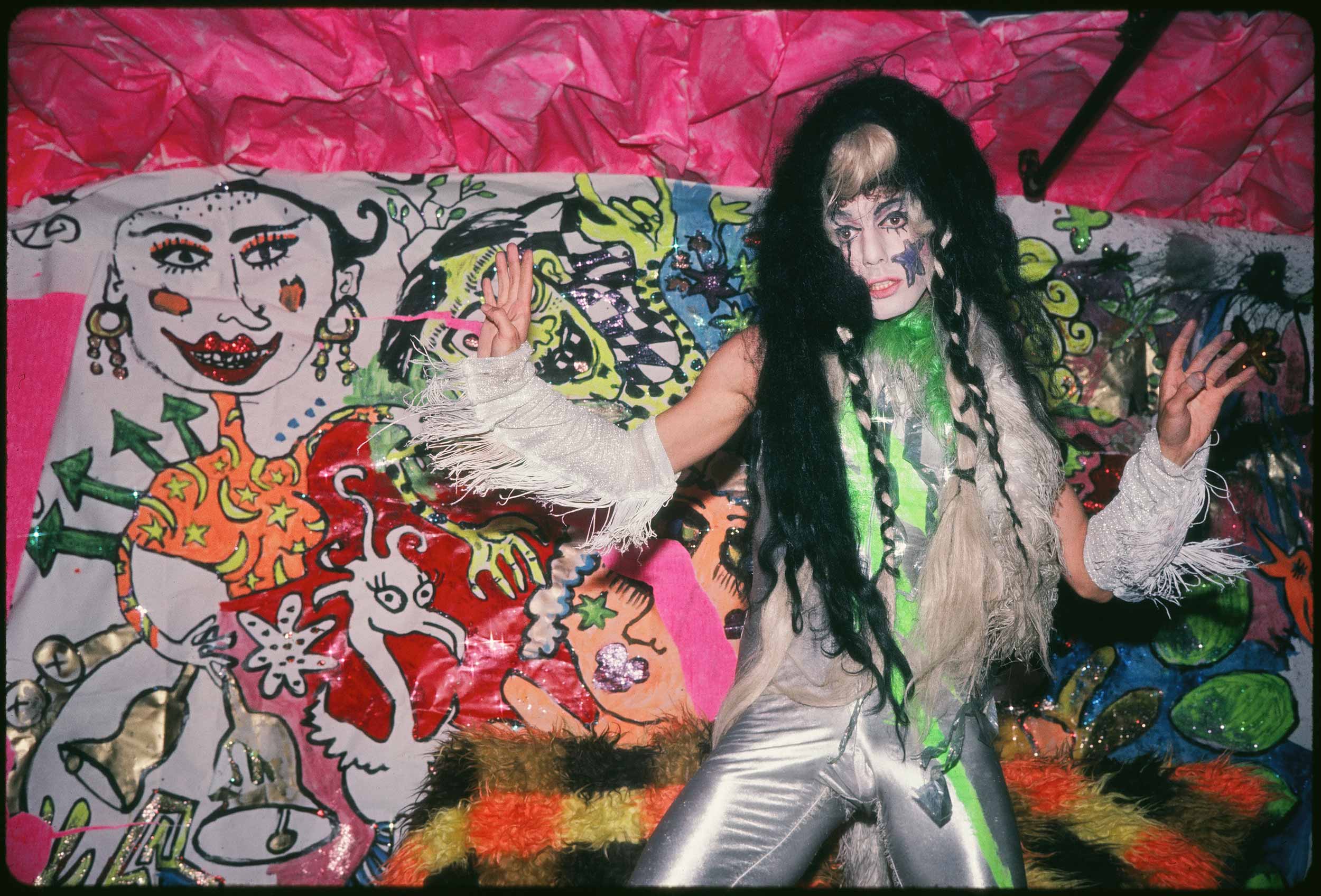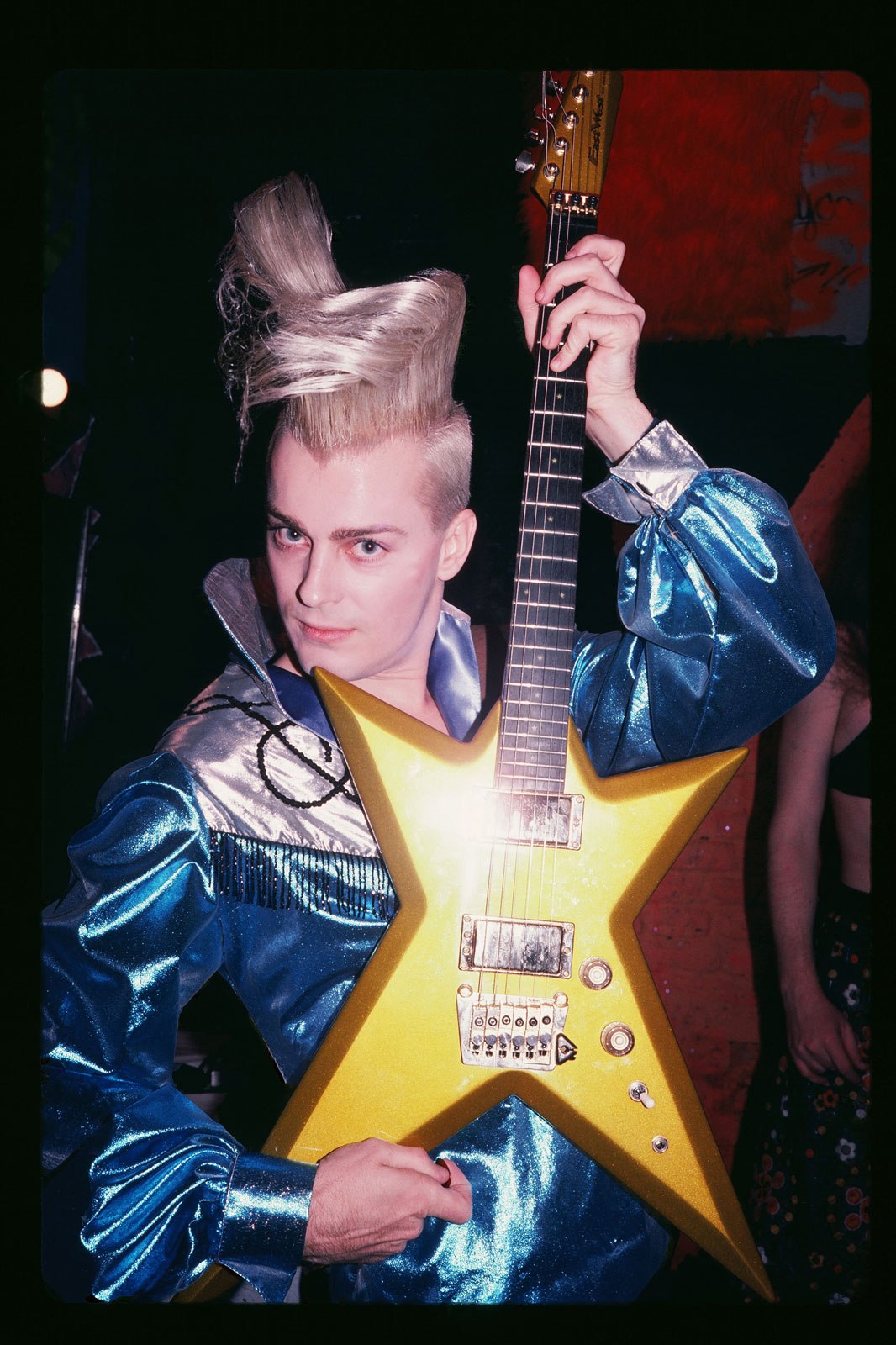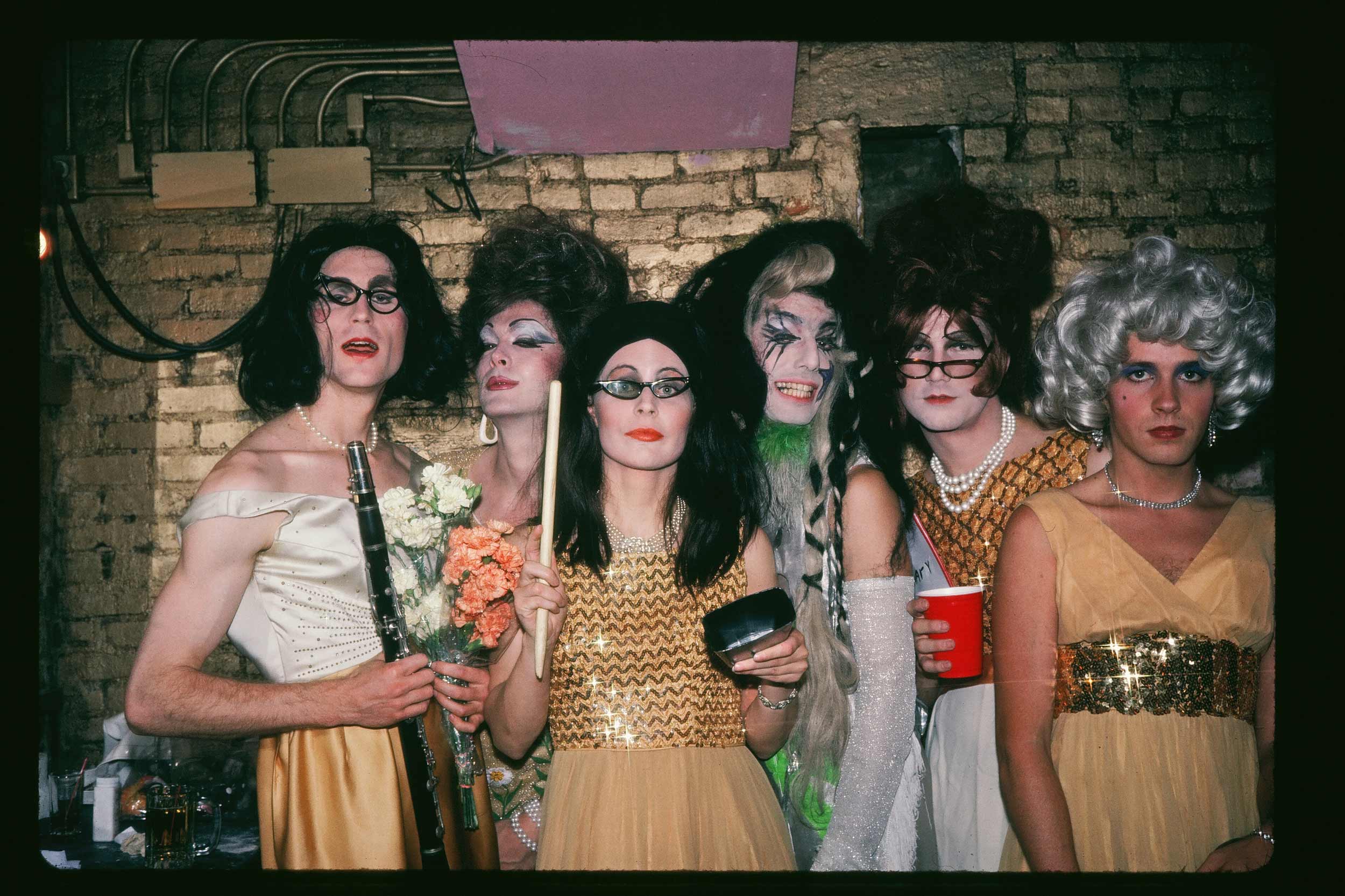Performer and hostess Linda Simpson, DJ Dany Johnson, and photographer Andé Whyland look back at a groundbreaking chapter in New York nightlife
For more than four decades, the Pyramid Club in New York has stood at the vanguard of the downtown avant-garde. Located on Avenue A and Seventh Street, just a stone’s throw from Tompkins Square Park, the Pyramid arose on the site of an old Polish bar. Soon after opening in 1979, it became the heart of the East Village underground: home to the burgeoning punk and drag scenes, and counterculture at the dawn of Reagan’s America. Embracing the spirit of rebellion against the status quo, the Pyramid became a space for community and creativity for radicals and revolutionaries of all stripes.
As a new generation of artists, musicians, and performers elevated the East Village to the forefront of the city’s explosive art scene, the Pyramid was host to celebrities and street corner legends alike. Drag, which had long been the provenance of female impersonators emulating Hollywood stars of yore, was reinvented at Pyramid by a new brigade, led by Lady Bunny, RuPaul, John Kelly, Hapi Phace, Tabboo!, and Sister Dimension, to name just a few. During the ’80s and ’90s, a new generation would reimagine drag, planting the seeds for a revolution that would change the face of fashion, music, and pop culture forevermore. For Document, Pyramid performer and hostess Linda Simpson, DJ Dany Johnson, and photographer Andé Whyland look back at a groundbreaking chapter in nightlife history.
Miss Rosen: When did you move to the East Village and what was the neighborhood like back then?
Dany Johnson: I moved to New York in 1977 and got an apartment down near the World Trade Center on Washington Street. I started going to the Mudd Club and Manic Panic, where I saw a flier for the Monster Movie Club at Club 57. I started going there, met Andi, and moved into her apartment on 10th Street. Rent was $135 a month.
Andé Whyland: I moved to New York in 1979. Apartments in the East Village were hard to find, but inexpensive [once] you got one. Things were fun and cheap, and we didn’t have to work that much. We were a few blocks away from the clubs. We stayed up all night and slept late. I wanted to be a photographer and was inspired by people who were also doing club pictures. It was like a family.
Linda Simpson: I arrived in New York in the early-’80s. The East Village was very rough-and-tumble back then, and it was considered dangerous. There were a lot of drug dealers and addicts stumbling around, so you had to watch your back. The Pyramid was located on Avenue A, so it was on the border of what was considered ‘No Man’s Land’ in many ways. The neighborhood was marginal and the rents were cheaper, so a lot of artsy types lived in the East Village. There was a creative spirit in the neighborhood.
Dany: The East Village was a small scene. You would always see the same people—everyone lived close by. You could walk down the street and see your friends sitting on a stoop, or go to clubs and see them there. I started going to the Pyramid in 1981. John Sex was doing a show. I went over with him and DJ’d before and after the show. Bobby Bradley, the manager at the time, hired me and said, ‘I want you to make the Pyramid like Club 57.’ I had DJ’d Mudd Club and Club 57, and was playing a lot of records [that] I found in thrift stores, and things I was into, like Soca, funk, and early rap. I DJ’d at Pyramid once a week for about a year, and then I got fired. One of the reasons was I didn’t really like New Wave music and I didn’t play it.
Andé: They weren’t treating Dany well. There were a lot of drugs and male dominance, so we stopped going there for a stretch. I started bartending and Dany DJ’d at King Tut’s Wah Wah Hut, a bar across the street. Everyone who was part of the inner circle at Pyramid would come and have a drink. Wendy Wild, Mr. Fashion, Michael Kitty, Doug Landau—it was a little happy family. I remember when Lady Bunny came in, and we had a nice conversation, and I said to Dany, ‘Maybe we should go back there?’
Miss Rosen: How did the Pyramid become the center of the East Village avant-garde drag scene?
Dany: I returned to the Pyramid in 1984; Bobby Bradley was no longer the manager, and Sister Dimension asked me to come back after they saw me at the Wah Wah Hut. I started DJing again and was there for another 10 years. When I came back, I played house, disco—club music that felt really gay and fun. Club 57 had a few drag queens, but they really went for it at Pyramid. It had a punky, East Village feel. With Lady Bunny, RuPaul, and Sister Dimension, there was definitely a Southern influence going on.
Linda: By the mid-80s, I was hanging out at Pyramid. It had a real reputation as being the center of a lively scene that incorporated drag. Back then, drag was scorned everywhere else in the world—it was not well understood by the general public. In that era, there was a danger to doing drag, because a lot of people associated it with a kind of perversion. They were wildly open about [homophobia], and that could lead to negative consequences. There were a lot of people who had no qualms about yelling death at you, threatening [you], or being violent. There was a thrill in being an outcast. You always had to be careful about where you were and know your boundaries.
“People didn’t get dressed up because it was a big night, it was just what they did.”
Andé: I had been taking pictures of my friends since the Club 57 days. I got a job working for Dinah Prince’s nightlife column at the Daily News from around ’84 to ’86. I usually went to things I enjoyed, and then sent her the photos with descriptions of the scene at clubs like Danceteria, Palladium, and Area. I was out with my camera one day, and we stopped in front of the Pyramid, where I took that black-and-white group shot—which is still my favorite.
We started going again, reconnecting with old friends and meeting new people, and it became our local place. You could go there any night of the week and run into your friends. I was bartending in the little bar under the DJ booth on Wednesday nights. and later on Saturday nights. In a lot of the pictures I have—even though people are super done up and look amazing—there was probably nobody else there, except some stragglers. People didn’t get dressed up because it was a big night, it was just what they did.
Linda: Drag was an offshoot of the performance art scene. The East Village queens were transforming something old and stale into a wildly creative form of expression. There were pioneering people like John Kelly, Hapi Phace, and Sister Dimension, who were the real avant-garde. It was all done cheaply. too, because there wasn’t an emphasis in the drag scene on having million-dollar outfits, well-coiffed wigs, and luxurious outfits. It was about putting yourself together, whether it be funny, sexy, or outrageous. A lot of people could go out of the house in head-to-toe drag having spent maybe $10. It was more about inventiveness than slickness.
Andé: It was pretty much doing what you wanted to do, and it was acceptable. That, and be nice.
Linda: I became friendly with Tabboo!, Lady Bunny, and other people on the scene. I really enjoyed what they were doing, and was having so much fun that I decided to join the gang as a drag queen in the late-’80s. I was struggling with how to name myself, so Tabboo! suggested Linda Simpson—Simpson is my real last name—and it stuck.
Miss Rosen: Can you share some of your favorite memories of the Pyramid?
Dany: I remember one night in 1987, there was this thing happening called Harmonic Convergence where the planets lined up. Sister Dimension, Hattie Hathaway, and Billy Beyond had this idea to have a special Harmonic Convergence night. He bought, like, 300 hits of acid and then I cut them up into little pieces. We brought them to coat check and whoever wanted could get some. Sister was DJing and gave us cans of Silly String. By two in the morning, everybody was so high, screaming with laughter, rolling on the floor, and spraying Silly String.
Andé: We were all friends and shared a creative interest in things. There was no mean boss hanging around, and we didn’t have anyone standing over us telling us what to do, so people did whatever they wanted. I’m a huge fan of Ethyl Eichelberger, who was the mother of the younger queens. They’d get on the bar and dance with her for tips. Even though she was a recognized performance artist in many circles, she just was happy to be up on the bar. I don’t know how much money they made—I can’t imagine [it was] much. Supposedly, RuPaul was really good at getting tips. It was a beautiful old space, and we were lucky to have it.
Linda: The best part of the Pyramid is that it was like a theater, with the stage elevated several feet above the dance floor. It had a great sound system and lighting. My favorite part was hanging out in the basement dressing room, which was quite roomy, with big mirrors and lockers for people to store their stuff. To get to the stage, we had to climb up a ladder. Even before we got there, there was a phone that connected the dressing room to the DJ booth. It was very off-off-off-off-Broadway, and I love that, because it was like hanging out with the cast. It had a sense of showbiz, like, Let’s put on a show!
Dany: We had our own space with Club 57, and Pyramid was a continuation of that—at least, until the new owners took over in the ’90s. It opened for happy hour and Wendy Wild would be bartending. She had a punk-polka band called Das Fürlines that started as a Monks cover band—the Monks were American servicemen in Germany who went AWOL, shaved the tops of their heads, and were a proto-punk band of the 1960s. But Das Fürlines also had some of their own songs, and would wear crazy St. Pauli Girl headdresses.
“A lot of people could go out of the house in head-to-toe drag having spent maybe $10. It was more about inventiveness than slickness.”
Linda: I had my first party, Channel 69, with Dany Johnson at the Pyramid in 1990, on Wednesday nights. After developing my drag persona and doing a few guest spots, I decided I wanted to do my own party, and Pyramid was the logical place to do it. At that time, most of the cast of characters had moved on or died, and the club was no longer considered that hip. It was kind of a risk, but it happened to be creatively successful, so we helped revive the club by nurturing a whole new tribe of drag queens. By the early-to-mid-’90s, it was an energized time for the club, and other nights started appearing.
It was a real learning experience: how to promote and run a party, and do my makeup at the same time. I made a lot of mistakes, but came out on top, because I’m still doing stuff. I was never that confident and I wasn’t sure how to react to gaining a little fame—not only with the Pyramid, but also through the magazine I was publishing at the time, My Comrade. I became a bit of a star on the downtown scene, and in some ways, it was a little awkward for me because it wasn’t something I was trying to attain. It was gratifying, but at the same time, it was a little like, Oh boy, I got myself into this.
Andé: I’m really attracted to costumes, makeup, and details, but I’m not good at regular pictures. It wasn’t like I walked into the Pyramid with a camera, snuck around, and grabbed pictures. These are all people I knew. So it was pretty easy for me to do whatever I wanted on the nights that I chose. I did my own printing in the kitchen and would start really late. At the time, I was taking color slides and black-and-white negatives. I would make 5×7 black-and-white prints and give them to the people in the pictures.
There was a loft upstairs, above the Pyramid, which they turned into an apartment and rented out. The manager, Brian Butterick, who went by Hattie Hathaway, asked me if I wanted to do a slideshow in the loft for New Year’s Eve. I said that I would love to, and that was one of the highlights of my life. The coolest, most beautiful people showed up and the slides kept running all night, and I have to thank them for covering my processing expenses, which was more than fair. People never got paid for these things and I didn’t expect that. I did it because I wanted to, and it made me feel good.
Miss Rosen: When did you begin to realize the era was coming to an end?
Linda: My party was about two years old. It was never a big moneymaker, and it didn’t last a long time. I started getting involved in other nightlife adventures, and I could read the writing on the wall, so I decided to end it. It was better to leave when things were hot, but it was a really difficult decision to make. I was back at the Pyramid later, throwing some nights, but never a regular party again.
Andé: After Channel 69 ended, Dany started doing a Saturday night party called The Ball in 1992 or ’93, which was our own night that went on for a year or two. The new owners had come at that point, and there were a lot of rules and things we had to go by. You couldn’t give away free drinks at the bar, and that changed the atmosphere. The new owners weren’t easy to get along with. We gave up Saturday night in 1994 to a woman named Otter Campbell, who didn’t last long. I don’t know if the Pyramid ever came back the same way after that. Wendy Wild died of breast cancer, and AIDS certainly took its toll. Everything changes and people move on to bigger clubs, where they can get paid.
Linda: The scene I entered into was completely fringe, and what happened was that these big clubs started using drag queens—many of them from the East Village scene. That became super popular, and drag suddenly became a nightlife novelty all over the place. Then, the worlds of fashion and music started plugging into the drag craze. Then, the media became curious, and there was this explosion where every talk show and magazine in town wanted to interview drag queens. The whole entertainment complex hopped on with movies, TV shows, and music videos, and [over] the course of several years, drag went from an underground phenomenon to a mainstream sensation.
Andé Whyland’s Shots: 1980-1986, and Linda Simpson’s The Drag Explosion chronicle the downtown New York nightlife and drag scenes of the 1980s and ’90s.



























